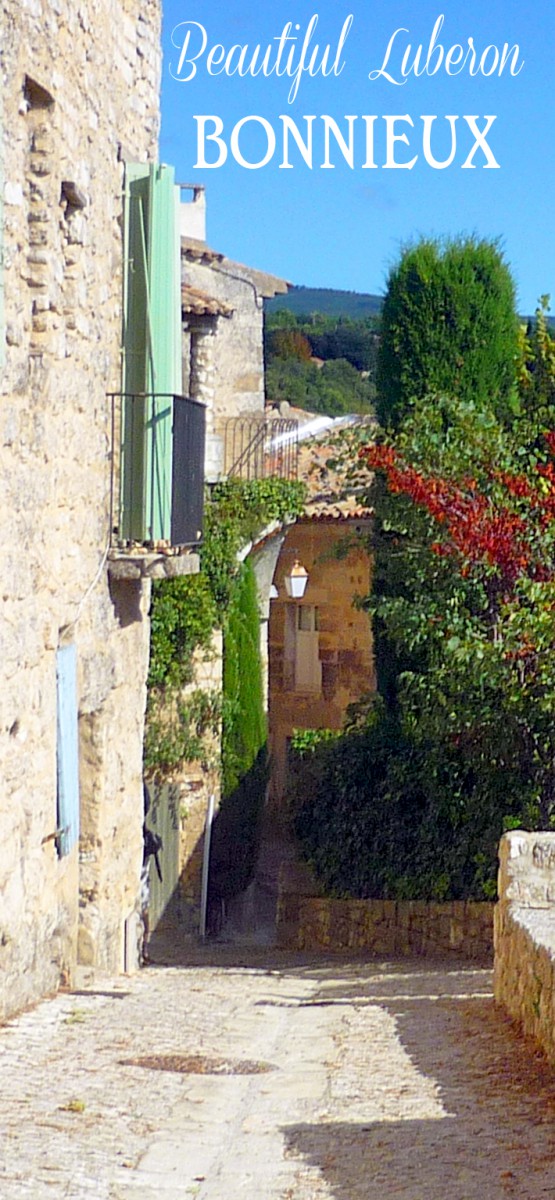During our last stay in Provence, we stumbled upon a hidden gem that we had never heard of before: the charming village of Viens.
Tucked away in the heart of the Provençal countryside, Viens is a true labyrinth of narrow, winding streets that invite you to get pleasantly lost.
As I wandered through this enchanting village, I uncovered architectural treasures from the Middle Ages, as well as from the 16th, 17th, and 18th centuries.

Viens, Provence © French Moments
Exploring Viens was like stepping back in time.
Every corner revealed a new delight, whether it was the impressive Clock Tower, the stately Renaissance castle, or the beautifully adorned mansions with their mullioned windows.
The village’s historical richness and its picturesque setting on a hill overlooking valleys and hills made my visit unforgettable.
Join me as I take you on a journey through Viens, sharing the beauty and history of this captivating village that truly embodies the spirit of ancient Provence.
Watch this short video on the Luberon!
Plan your trip
- 🛏 Find the best accommodations in the Luberon on Booking.com
- 🚙 Rent a car in Aix-en-Provence or Marseille-Provence Airport
- 🙋♀️ Get the PASS CÔTE D'AZUR and take your pick from more than 100 amazing experiences!
- 🤩 Visit the beautiful Provençal region of Luberon
- 🚐 Join a 6-hour tour of Lourmarin, Bonnieux, Roussillon, and Gordes by air-conditioned minibus
- 🚘 Discover Provence in a 2CV. Stroll along exceptional roads and enjoy a piece of Luberon all to yourself!
- 🥗 Experience a black truffle hunting tour in a Luberon plantation
- 📚 Read the DK Eyewitness Provence and the Côte d’Azur Travel Guide
- 🗺️ Download the map of the village.
- 🚗 There are several parking spaces near the entrance to the old village. For example, try the car park of Route d'Apt.
Viens: A Bit of History
Let’s step back in time as we recall the storied past of Viens.
Viens in the Middle Ages
The first mention of the village dates back to 1006, under the name Vegnis.
This was the name of a castrum founded in 990.

Tower of the Pousterle © French Moments
In the 12th century, the Saint-André Abbey of Villeneuve-lès-Avignon owned a priory here, which served as the parish church until the early 13th century, along with two churches, Saint-Ferreol and Saint-Jean, from which it derived its income.
In the 12th century, the fief of Viens was under the county of Forcalquier.
Then, it passed to the Count of Provence in 1220.
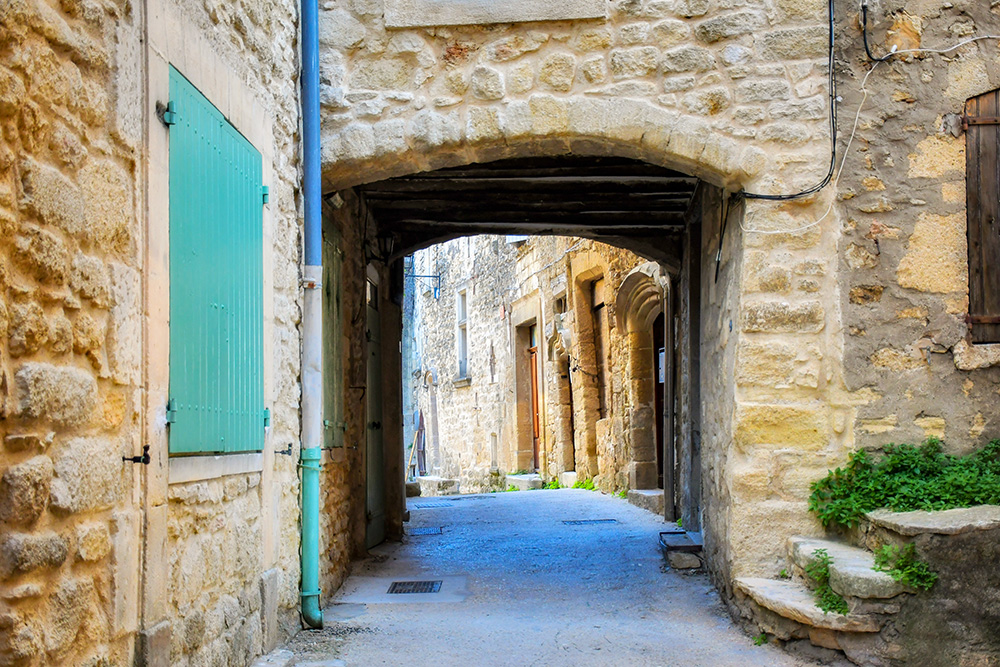
Old street of Viens, Provence © French Moments
A prosperous town in the 17th and 18th C.
Viens experienced a prosperous period in the 17th and 18th centuries.
Markets and fairs were held here, and there were many craftsmen, including coppersmiths, masons, blacksmiths, and weavers.

Rue Notre-Dame © French Moments
There were 1320 inhabitants in 1716, which is double today's population.
However, today, the population easily reaches 1500 residents if we count the holidaymakers in summer.

Rue du Château © French Moments
The Discovery Guide of Viens
Here's some tourist information to help you explore the Provencal village.
🎦 Check out my guided walk on YouTube to explore Viens with me:
Understanding the Village
Viens is located 16 km east of Apt and 28 km west of Manosque.
The village overlooks a landscape of hills and valleys in the Vaucluse département, not far from the Alpes de Haute-Provence département.

The view from Viens, looking north towards the Montagne de Lure © French Moments
Viens still retains some businesses such as a grocery store, a bakery, a restaurant, and a honey farm, making it an ideal countryside getaway.
One can easily become disoriented while wandering the streets of the old village. As for me, I had to study the layout carefully on my first visit to Viens.

Old street of Viens, Provence © French Moments
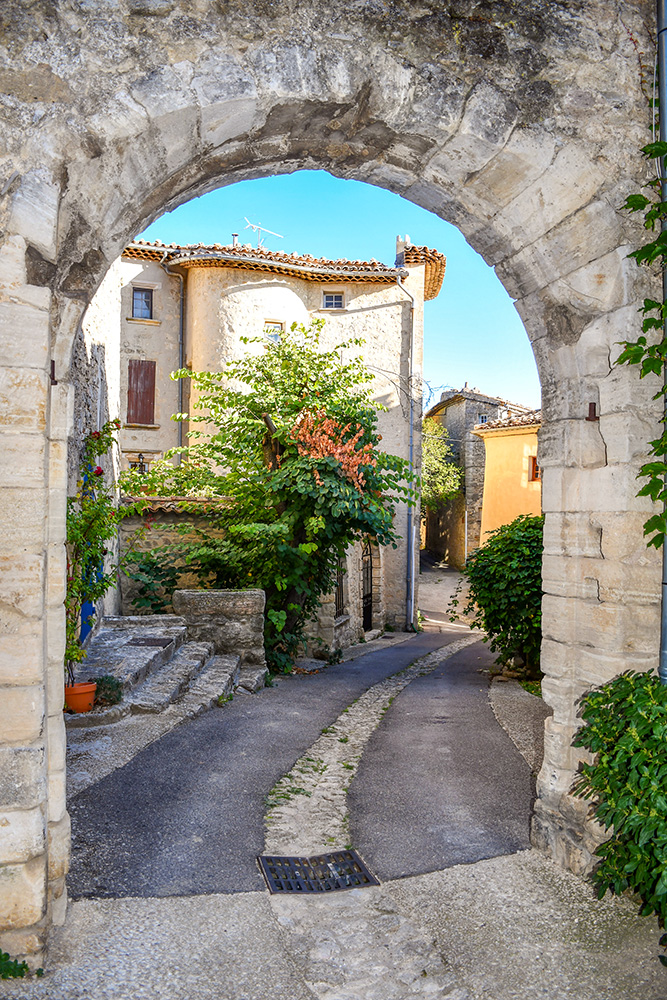
Archway of the Castle courtyard © French Moments
The Village Walk of Viens
Let's begin our exploration of Viens from the Allée des Platanes (Route d'Apt) at the west entrance of the historic village.
The Fortified Gate of Le Portail
In front of us stands the Portail, the fortified gate topped with the Clock Tower.
This is the main entrance to Viens, which was accessible to carriages.
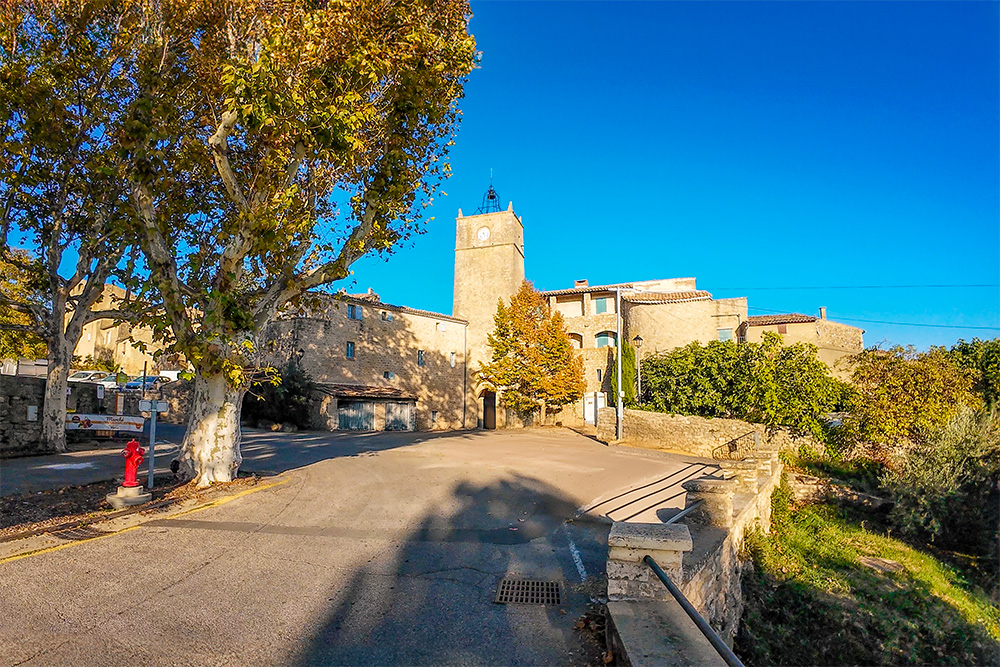
Le Portail © French Moments
The base of the gate is Romanesque, while the upper part dates back to the 16th century.
The bell dates from the 14th century and the one-handed clock mechanism from 1862.

The clock tower © French Moments
To the left of the gateway, have a look at the old village washhouse.
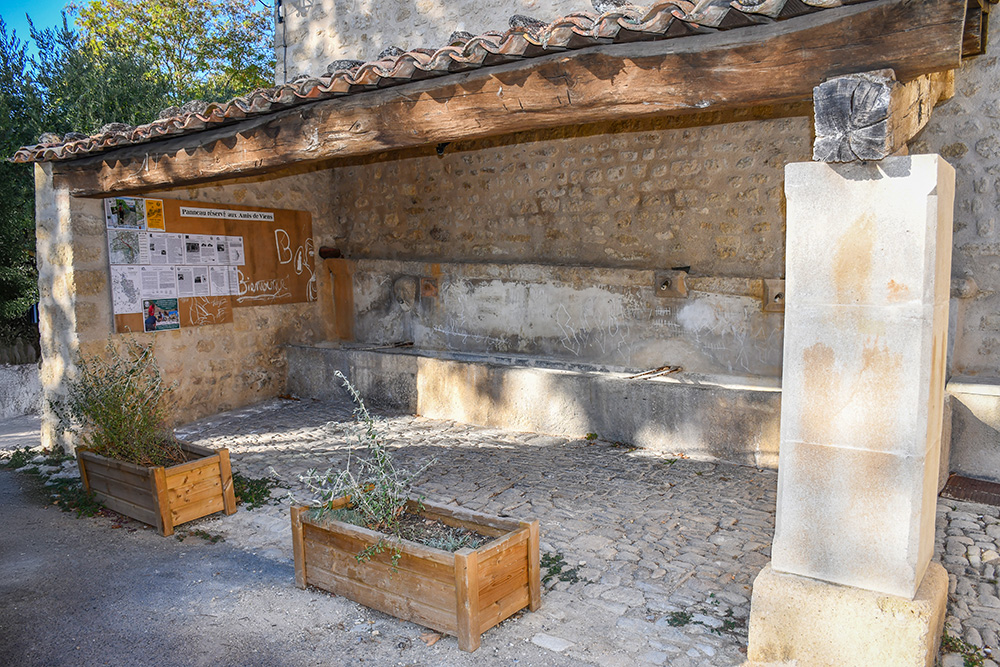
The Washhouse © French Moments

The fountain of the washhouse © French Moments
Pass under the arch and turn left onto the Rue de la Porte Neuve.
The Old Village Townhouses
Immediately, you are transported into another world: a maze of narrow and winding streets where it is easy to get lost.

Rue de la Porte Neuve © French Moments

The old streets of Viens © French Moments
At the end of the Rue de la Porte Neuve, take a left onto the Rue du Château.

Rue du Château © French Moments
Take a look at the beautiful inner courtyard of the Hôtel Monier d’Arnaud, dating from the Renaissance.

The courtyard of Hôtel Monier d’Arnaud © French Moments

Hôtel Monier d’Arnaud © French Moments
The Castle
At the end of the street is the castle courtyard.
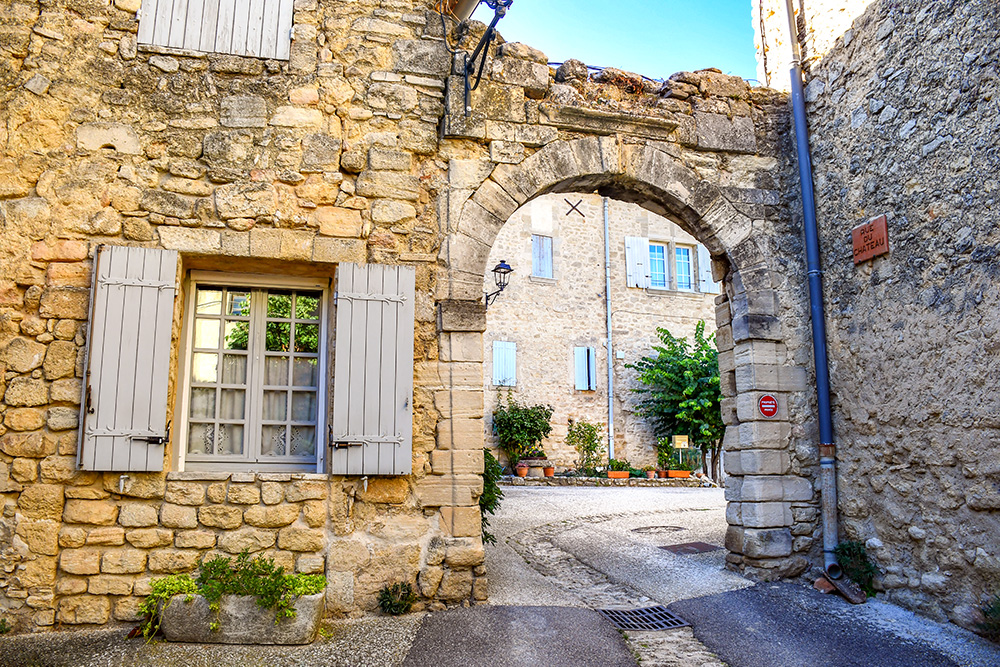
The castle courtyard of Viens © French Moments
The castle was built in the 16th century and renovated in the 18th and 19th centuries.

Castle of Viens © French Moments
Behind the castle stands the Tower of the Pousterle, whose construction dates back to the late 15th century.

Tower of the Pousterle © French Moments
Rue du Four and Viewpoint
Retrace your steps and take a left onto the Rue du Four.

Rue du Four © French Moments
At the end of the street, we will admire a stunning panorama.
It then becomes clear that Viens is a perched village above the valley.
You will discover a panorama from the Montagne de Lure to the Grand Luberon.

Montagne de Lure © French Moments

Panorama of Rue du Four © French Moments
Hôtel Monier de la Quarrée and Grande Rue
The tall house in front of you is of medieval origin.
This is the former Hôtel Monier de la Quarrée.
The façade is pierced with Renaissance mullioned windows.

Hôtel Monier de la Quarrée © French Moments
You are now on the Grande Rue, which, I admit, does not at all have the image one might have of a village’s high street.

Grande Rue © French Moments
You will then arrive at the intersection where we were earlier, coming back from the castle.
Take a left onto the Rue du Chat Noir.
Rue du Chat Noir
This transverse cobblestone street will lead us to the Rue de la Place.
It was joked that the Black Cat Street was just wide enough for a cat to pass through.

Rue du Chat Noir © French Moments
Curiously, the owners of the famous Café du Chat Noir in Paris once made their home here.
Turn left towards the Place Centrale.
Place Centrale
We arrive at the area that is perhaps the most picturesque in Viens, with its old houses and vaulted passageways.

The porch leading to the Place Centrale © French Moments
Here is the Place Centrale, the prettiest square in Viens.

Place Centrale and Hôtel des Comtes de Sault © French Moments
The little square was the old market square.
It was the centre of social and administrative life.
The square is bordered by two mansions: the Hôtel des Comtes de Sault (or Maison d’Agoult) and the Hôtel des Commandeurs.
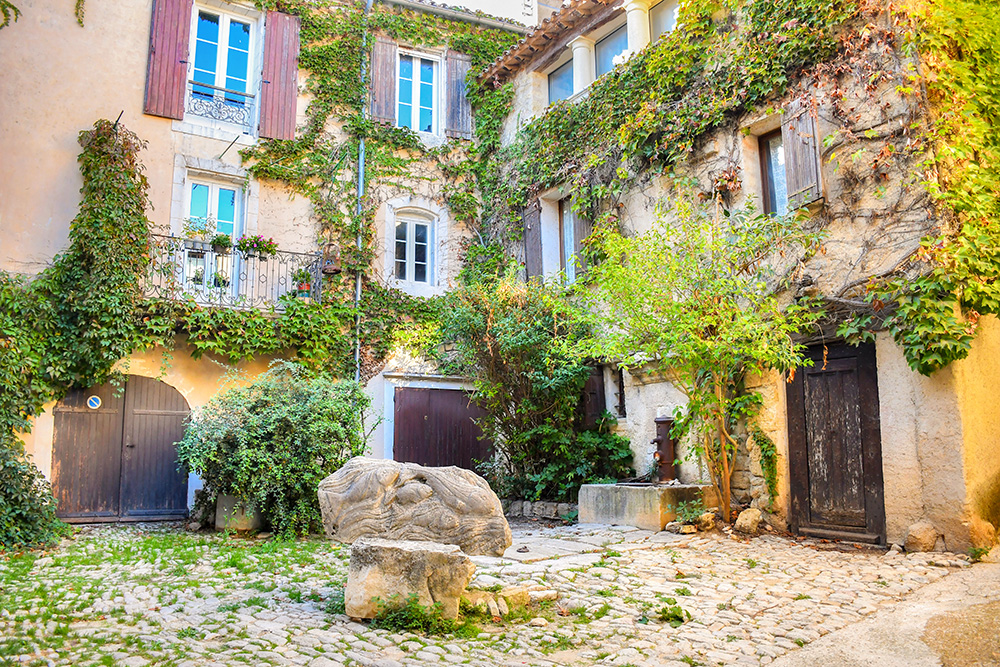
Place Centrale and Hôtel des Comtes de Sault © French Moments

Hôtel des Commandeurs © French Moments
Rue Notre-Dame
Take the Rue Notre-Dame.
The green space to the right is the Place Roger-Bernard.
This was the site of the medieval Jewish quarter.
The Jewish community in Viens was small and was dispersed in 1498 during the general expulsion of Jews from the region.

Rue Notre-Dame © French Moments
Turn around to admire the back of the Hôtel des Commandeurs and its modern Gothic trilobed windows.

Rue Notre-Dame © French Moments
Notre-Dame Gate
Pass through the fortified Notre Dame Gate.

Notre-Dame Gate © French Moments
It is also called the Saracen Gate in memory of the deliverance by Guillaume de Forcalquier, lord of Viens in 973, of Saint Mayeul, abbot of Cluny, who was kidnapped by the Moors in the Alps.
St Hilaire Church
From the terrace is the lovely view of the church of Viens and its Lombard Romanesque bell tower from the 13th century.

The St Hilaire Church © French Moments
The church of Saint Hilaire was built in the 12th century outside the ramparts and slightly lower down.

The church tower © French Moments
Place du Ravelin and Rue du Faubourg
You will then arrive at the Place du Ravelin.
Walking along the Rue du Faubourg, which follows the path of the old medieval rampart.

Rue du Faubourg © French Moments
Back to the medieval village
Go back into the medieval village by taking the next transverse cobblestone street of the right which leads to the Rue de la Place.
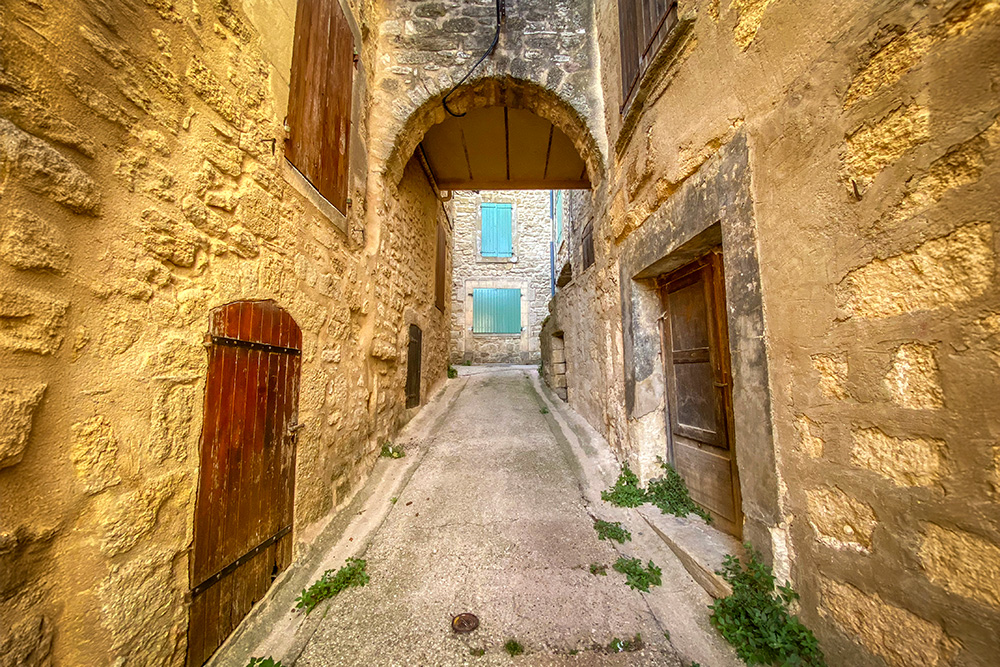
Old narrow street of Viens © French Moments
From there, take a left and retrace our steps to the clock tower.
Like in a maze, you have found the exit!

Old street of Viens © French Moments
Find out more
Here are some pages from our blog and other websites to find out more about this Provencal destination.
- Discover the hilltop villages of the Luberon
- Explore the neighbouring villages of Saint-Saturnin-lès-Apt and Oppedette
- Find out more about Provence-Alpes-Côte d'Azur
- The official tourist office of the area

Viens, Provence © French Moments
Where to stay near Viens
Viens and surroundings have a high capacity for holiday accommodation. The commune and its surroundings has hotels, bed and breakfasts (covering all price ranges), estate agencies offering seasonal rentals and gîtes.
Click here to book your accommodation in the Luberon or browse the map below:
What to do in the Luberon
Be inspired by a list of things to do in the Luberon:
Pin Viens on Pinterest
